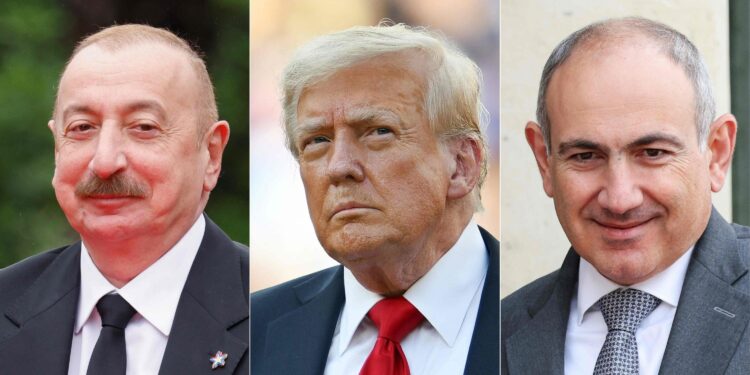In a significant geopolitical development, former U.S. President Donald Trump has been linked to a newly brokered deal aimed at reshaping the balance of power in the South Caucasus region. The agreement, reported to sideline Russia and Iran’s influence, marks a potential shift in the complex dynamics that have long defined this strategic crossroads. As regional actors reassess their positions, questions arise about the deal’s implications for stability, alliances, and the broader contest for influence between global and regional powers. This article delves into the details of the Trump-mediated arrangement and examines whether it effectively marginalizes Moscow and Tehran in the South Caucasus.
Trump Brokered Deal Shifts Power Dynamics in the South Caucasus
The latest agreement, facilitated by former U.S. President Donald Trump, has significantly altered the strategic chessboard of the South Caucasus, a region long dominated by Russian and Iranian influence. This meticulously brokered deal introduces new corridors of political and economic cooperation between Armenia, Azerbaijan, and Georgia, effectively recalibrating alliances and trade routes that Russia and Iran had historically controlled. The deal not only enhances connectivity but also promotes energy independence for the involved countries, undermining Moscow’s and Tehran’s traditional leverage.
Key components of the agreement include:
- Enhanced regional infrastructure: New rail and road links connecting the Caspian Sea to the Black Sea.
- Energy diversification: Alternative pipelines to reduce reliance on Russian and Iranian energy supplies.
- Security cooperation: Multilateral frameworks to address border disputes and regional stability.
| Country | New Role | Impact on Russia & Iran |
|---|---|---|
| Armenia | Gateway for trade to Europe | Less dependency on Russian routes |
| Azerbaijan | Energy exporter with new access routes | Reduces Iranian energy influence |
| Georgia | Transport hub linking Asia to Europe | Diminished Russian strategic control |
Assessing the Impact on Russian and Iranian Influence in the Region
The recent diplomatic breakthrough, spearheaded by former U.S. President Donald Trump, has introduced new dynamics into a region historically dominated by Russian and Iranian influence. By facilitating unprecedented agreements between Armenia and Azerbaijan, the United States has effectively challenged Moscow’s traditional role as the sole mediator and security guarantor in the South Caucasus. This recalibration has the potential to curb Russia’s ability to exert unilateral power, especially as Washington’s involvement diversifies the array of external actors shaping regional geopolitics.
Similarly, Iran, which has long regarded the South Caucasus as within its strategic backyard, faces subtle yet consequential shifts. The deal places increased emphasis on economic integration and transport corridors that may bypass Iranian territorial and logistical frameworks, diminishing Tehran’s leverage. However, both Russia and Iran retain significant soft power tools, including energy dependencies and sectarian affiliations, which ensure they remain key players despite recent setbacks.
- Russia: Continuation of military presence and peacekeeping forces.
- Iran: Cultural and religious influence among minority communities.
- Shift: Reduced monopoly over mediation and development projects.
| Factor | Russian Influence | Iranian Influence |
|---|---|---|
| Security Presence | Peacekeeping troops | Minimal |
| Economic Influence | Energy exports, infrastructure | Trade routes, local markets |
| Cultural/Religious Influence | Limited, mainly Orthodox Christian ties | Strong, especially among Shiite Muslim communities |
| Political Leverage | Mediation role, peace agreements | Influence through sectarian alliances and border policies |
Strategies for Regional Stability Amid Changing Geopolitical Alliances
As geopolitical dynamics shift rapidly in the South Caucasus, key players are recalibrating their approaches to safeguard regional stability. The evolving alliances present an opportunity to establish a balance of power that curtails undue influence from traditional actors like Russia and Iran. Central to these efforts is the diplomatic engagement led by external powers, notably the United States under the Trump administration, emphasizing partnerships that promote economic integration and conflict resolution. By fostering multilateral cooperation, stakeholders aim to reinforce sovereignty while mitigating the risks of renewed hostilities.
Effective strategies now focus on several core components:
- Enhanced security frameworks involving local and international forces to deter aggression.
- Economic incentives that encourage collaboration across borders, such as energy corridors and trade linkages.
- Political dialogues that include marginalized groups and neighboring states to address underlying tensions.
| Strategy | Key Benefit | Primary Actor |
|---|---|---|
| Security Cooperation | Reduced military tensions | South Caucasus States & NATO |
| Economic Integration | Shared prosperity | US & Regional Governments |
| Inclusive Political Dialogue | Conflict resolution | International Mediators |
In Summary
As the South Caucasus continues to be a strategic crossroads, the ramifications of a Trump-brokered deal may reshape regional alliances and influence power dynamics. While the agreement appears to constrain Russia and Iran’s traditional sway, the long-term impact remains uncertain amid complex geopolitical interests. Observers will be watching closely to see whether this diplomatic maneuver ushers in sustained stability or simply recalibrates existing tensions in this pivotal area.








![Leyla Aliyeva visits Azerbaijan National Carpet Museum [PHOTOS] – AzerNews](https://europ.info/wp-content/uploads/2025/12/3035623-leyla-aliyeva-visits-azerbaijan-national-carpet-museum-photos-azernews-350x250.jpg)





![Poland and France push ahead with defense pact after Paris talks [VIDEO] – TVP World](https://europ.info/wp-content/uploads/2026/01/3036754-poland-and-france-push-ahead-with-defense-pact-after-paris-talks-video-tvp-world-120x86.jpg)

